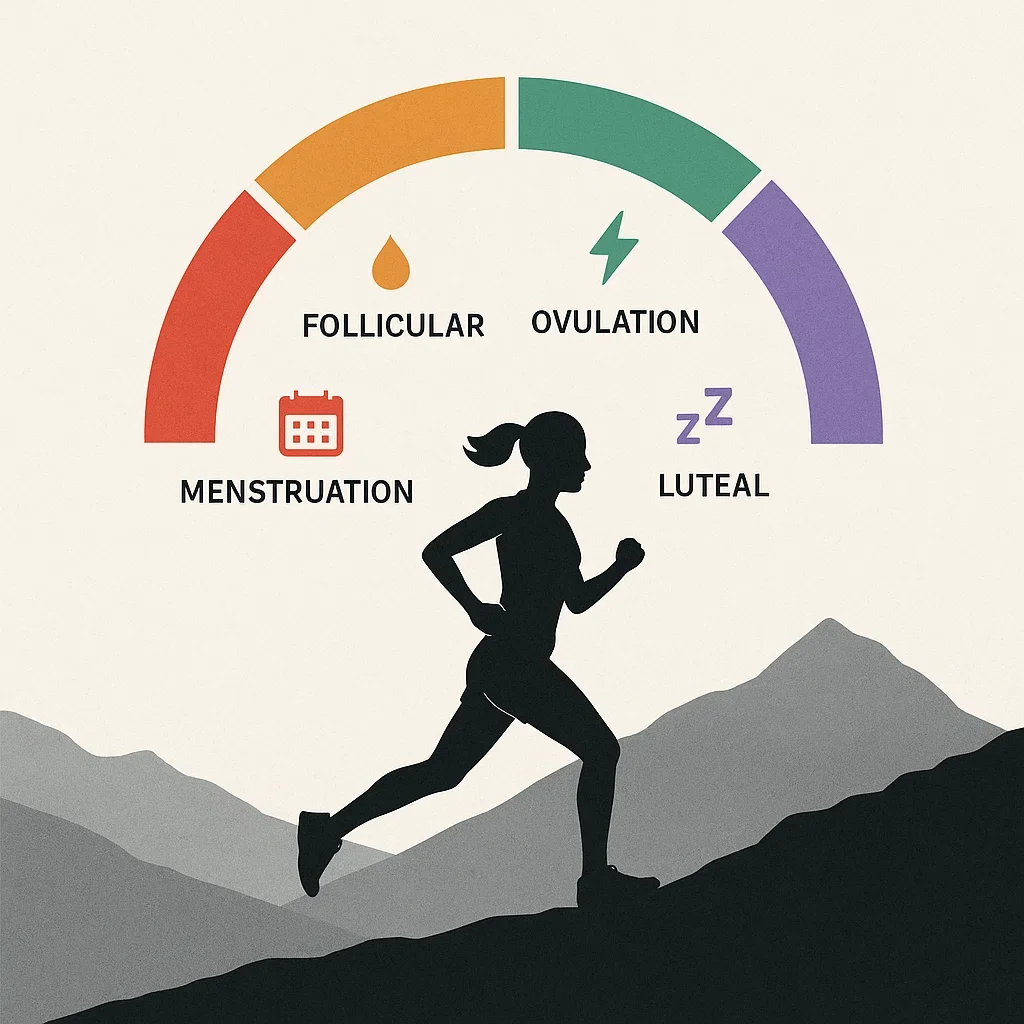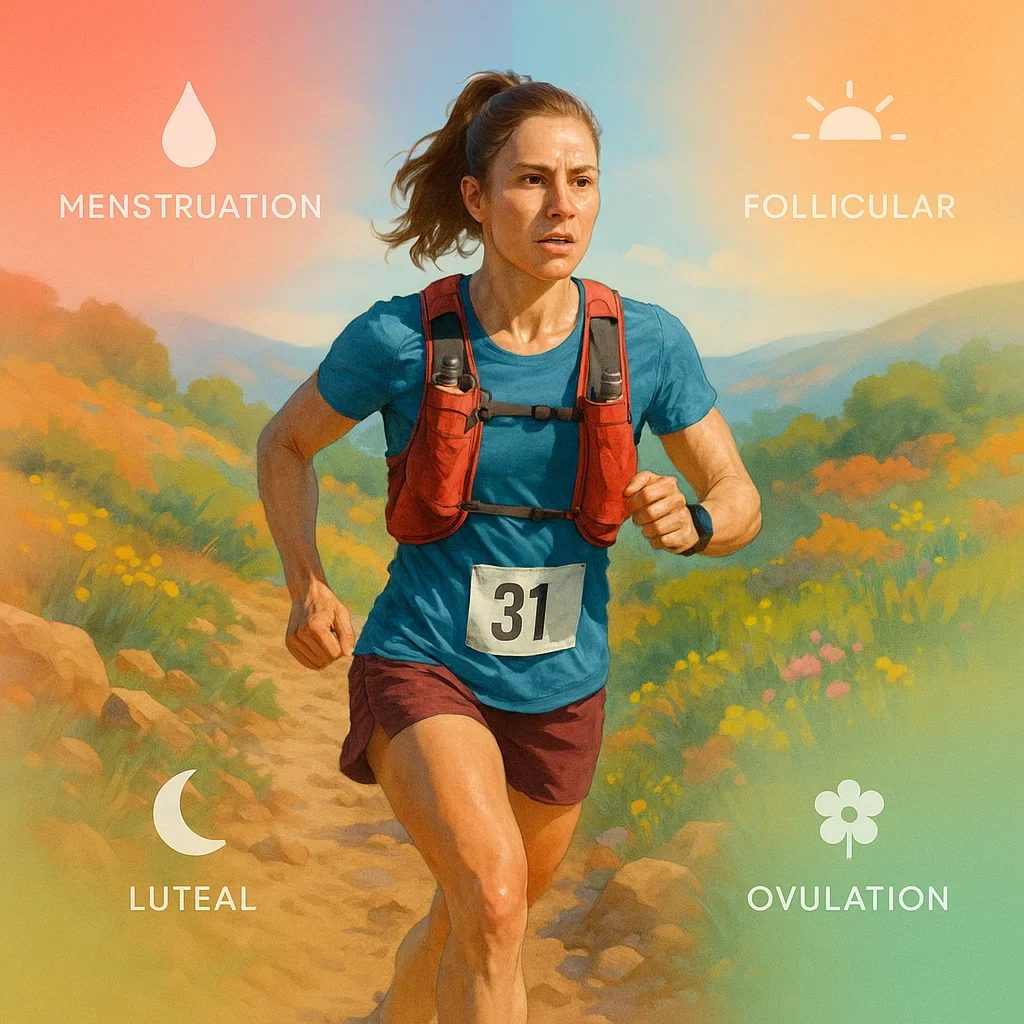Why Menstrual Cycle Phases Matter in Ultramarathons
Endurance running isn’t just about training plans and finish lines—it’s about working with your own body, every step and every month. For female ultrarunners, understanding how the menstrual cycle phases influence energy, recovery, and mindset is a true performance advantage.
The days of “just tough it out” are over. With more women than ever running ultras, we’re learning that cycle awareness can transform how you train, how you race, and how you feel on the journey. This guide breaks down each phase, what actually changes, and how you can adapt for your best results—no matter where you are in your cycle.
What’s inside?
• A runner’s guide to the four phases of the cycle
• How each phase affects stamina, mood, and injury risk
• Practical strategies for training, racing, and recovery
• Real stories and science you can use
The Menstrual Cycle: Four Phases Every Runner Should Know
The menstrual cycle isn’t just about periods. It’s a 28-ish day flow of shifting hormones, each phase with its own impact on your training and well-being. Here’s the cycle, phase by phase:
- Menstruation (Days 1–5): Your period starts, and both estrogen and progesterone hit their lowest point. Runners may feel tired, achy, or heavy-legged, but some also describe a sense of “reset.” Cramps and low mood can affect motivation and recovery.
- Follicular Phase (Days 6–13): Estrogen begins to rise. Most women experience a steady boost in energy, mood, and confidence. Muscles recover faster, soreness fades, and it’s a great window for speedwork or longer runs.
- Ovulation (Day 14): Estrogen peaks and an egg is released. Many runners feel at their physical and mental best—high power, great motivation. But joint laxity increases, which can elevate the risk for injuries like sprains or ACL tears.
- Luteal Phase (Days 15–28): Progesterone rises, leading to subtle shifts: increased body temperature, more sweat, changes in hydration needs. Some runners feel sluggish, bloated, or struggle with sleep. PMS symptoms—cravings, mood dips, sore muscles—can show up.
Lost Pace insight: Not every runner feels every phase the same way. The key is to track your own rhythm and notice your unique strengths and challenges.
How Each Menstrual Phase Influences Endurance Performance
Does your period really affect your running? And if so, how much? Science shows the effect is real—but deeply individual. Here’s what we know about each phase and your ultra performance:
- Menstruation: Fatigue, cramps, or poor sleep can blunt stamina and motivation. But studies confirm that many women can run strong, set PRs, and complete ultras during their period—especially with good fueling and rest.
- Follicular Phase: As estrogen rises, muscles recover faster, energy climbs, and pain tolerance may improve. Most runners find this is the best time for high-quality workouts, long runs, or even races.
- Ovulation: Peak estrogen can boost confidence and performance, but be careful—joint laxity is higher, so dynamic drills and trail races require extra attention to form and warm-up.
- Luteal Phase: Progesterone’s effects (higher temp, fluid retention, mood shifts) can make workouts feel tougher. Recovery may slow, and motivation can dip. That said, consistent training and mindful nutrition help most runners push through.
What the research says: Recent reviews (Carmichael et al., 2021; Muriach et al., 2021) show there’s no single “best” or “worst” phase for all runners—subjective symptoms matter more than objective performance changes. (References in Further Reading)
Tip: Keep a simple log of your cycle and training. After 2–3 months, you’ll spot when to push hard and when to prioritize recovery.
How Each Menstrual Phase Influences Endurance Performance
Does your period really affect your running? And if so, how much? Science shows the effect is real—but deeply individual. Here’s what we know about each phase and your ultra performance:
- Menstruation: Fatigue, cramps, or poor sleep can blunt stamina and motivation. But studies confirm that many women can run strong, set PRs, and complete ultras during their period—especially with good fueling and rest.
- Follicular Phase: As estrogen rises, muscles recover faster, energy climbs, and pain tolerance may improve. Most runners find this is the best time for high-quality workouts, long runs, or even races.
- Ovulation: Peak estrogen can boost confidence and performance, but be careful—joint laxity is higher, so dynamic drills and trail races require extra attention to form and warm-up.
- Luteal Phase: Progesterone’s effects (higher temp, fluid retention, mood shifts) can make workouts feel tougher. Recovery may slow, and motivation can dip. That said, consistent training and mindful nutrition help most runners push through.
What the research says: Recent reviews (Carmichael et al., 2021; Muriach et al., 2021) show there’s no single “best” or “worst” phase for all runners—subjective symptoms matter more than objective performance changes. (References in Further Reading)
Tip: Keep a simple log of your cycle and training. After 2–3 months, you’ll spot when to push hard and when to prioritize recovery.
Common Challenges & How to Overcome Them
- Cramps, Bloating, and Heavy Flow: Warm up longer, run easy on tough days, and use period products you’ve tested on long runs (menstrual cup, tampons, or period-proof shorts). Don’t skip iron-rich snacks and stay hydrated!
- Fatigue & Mood Swings: Prioritize sleep and rest days, especially in the luteal phase. Practice self-compassion—sometimes, lowering your training load by 10–20% for a few days is the smartest move.
- Injury Risk During Ovulation: Include extra mobility and strength work. Focus on running form and stability drills; avoid aggressive terrain if you feel “wobbly.”
- Nutrition & Cravings: Don’t fight cravings with restriction—just aim for quality carbs, healthy fats, and magnesium-rich foods. Add more snacks if you’re hungrier pre-period.
- Stigma & Communication: Talk openly with your coach or running group. More runners are sharing cycle data than ever—your voice helps break the taboo.
Pro tip: Use your toughest months as a guide. If your period gets heavier, disappears, or PMS gets worse, check in with a sports doctor. It’s a sign to tweak your training or fueling—not a failure.
Menstrual Cycle Phases and Endurance Performance in Ultramarathons
HTML preview is not yet fully accessible. Please switch screen reader to virtualized mode to navigate the below iFrame.
HTML preview is not yet fully accessible. Please switch screen reader to virtualized mode to navigate the below iFrame.
HTML preview is not yet fully accessible. Please switch screen reader to virtualized mode to navigate the below iFrame.
HTML preview is not yet fully accessible. Please switch screen reader to virtualized mode to navigate the below iFrame.
Tracking Your Cycle for Smarter Endurance Training
The best way to use your menstrual cycle as a training tool? Track it. By logging symptoms, energy, and workout quality, you’ll discover your own patterns—often within 2-3 months.
- Simple methods: Mark period start dates in your training log, and add notes for cramps, mood, or sleep.
- Go digital: Apps like Clue, FitrWoman, Garmin Connect, or Apple Health let you log symptoms and overlay cycle info on training data.
- What to look for: Are your strongest runs during a specific phase? Do injuries cluster around ovulation? Is PMS derailing long runs?
- Coach’s tip: Share your logs with your coach (or your future self) to spot trends and adjust your plan for next month.
❓ Frequently Asked Questions
🏃♀️Can I run ultras during my period?
🗓️Which phase is best for hard workouts?
😩How do I handle cramps and fatigue?
📲Do I need a special app to track my cycle?
🦵Is injury risk really higher during ovulation?
🥗Should I change my nutrition throughout the cycle?

📚 Further Reading & Resources
Final Thoughts & Takeaways
Every phase of your cycle brings unique challenges—and new strengths. Track your patterns, adapt with self-compassion, and know that you can run strong at any point in the month. Sharing your journey not only helps you, but empowers other women in the ultra community.
The real finish line is learning to work with your body, not against it.
Lost Pace

About the Author
Lost Pace is an ultramarathon runner, shoe-tester and the founder of umit.net. Based year-round in Türkiye’s rugged Kaçkar Mountains, he has logged 10,000 + km of technical trail running and completed multiple 50 K–100 K ultras.
Blending mountain grit with data, Lost analyses power (CP 300 W), HRV and nutrition to craft evidence-backed training plans. He has co-written 260 + long-form guides on footwear science, recovery and endurance nutrition, and is a regular beta-tester of AI-driven coaching tools.
When he isn’t chasing PRs or testing midsoles, you’ll find him sharing peer-reviewed research in plain English to help runners train smarter, stay healthier and finish stronger.
Ultrarunner · Data geek · Vegan athlete

